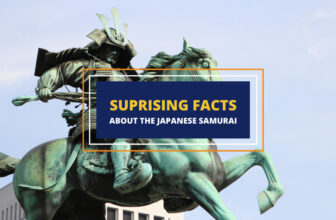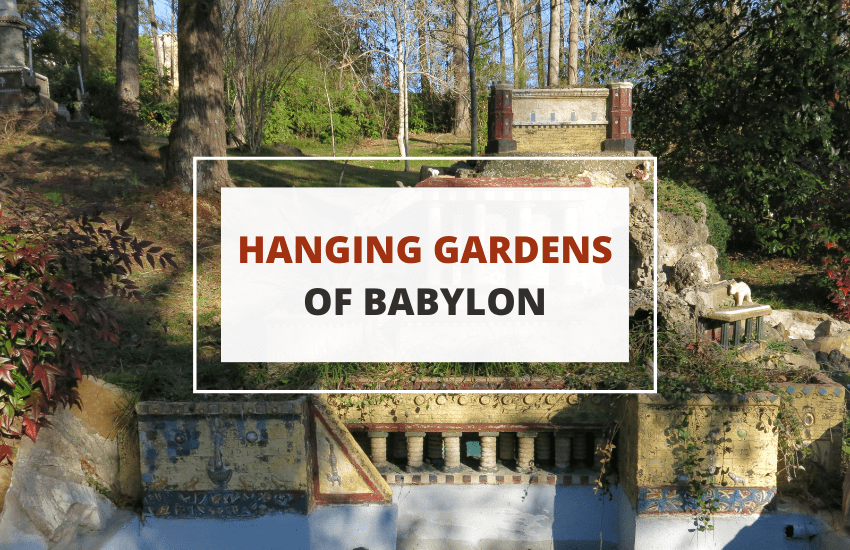
Table of Contents
You’ve probably seen or heard about the beauty of the Hanging Gardens of Babylon. It’s considered the second wonder of the ancient world, with many ancient historians and travelers praising its charm and the feats of engineering required to erect such a wonderful structure.
Despite all this, the Hanging Gardens of Babylon don’t exist today. On top of that, contemporary archaeologists and historians lack enough evidence to support these claims.
Could it be an exaggeration? Or were all traces of this marvelous structure destroyed beyond recognition? Let’s find out.
History of the Hanging Gardens of Babylon
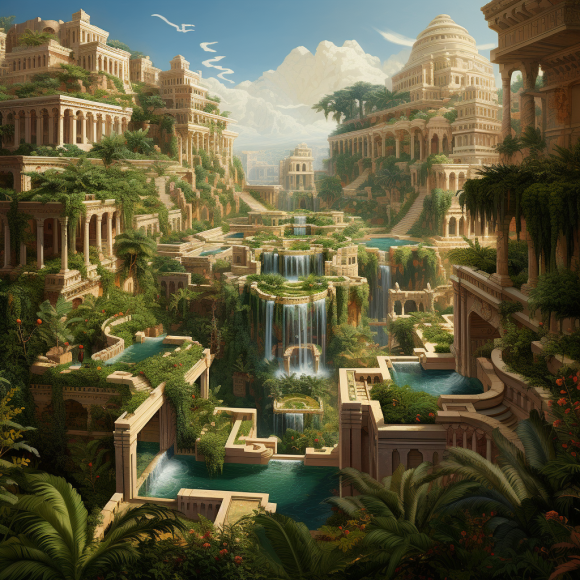
According to ancient historians and travelers, specifically from the Greek and Roman periods, the Hanging Gardens of Babylon were depicted as this tall building with lush, terraced roof gardens resembling a mountain.
The gardens were built during 600 B.C. They were well-maintained and irrigated with the water flowing from the Euphrates River. Although they were said to be purely ornamental, with fragrant flowers, exquisite trees, sculptures, and waterways, the gardens also housed various fruit trees, herbs, and even some vegetables.
Compared to the open and dry plains of the desert in many parts of Babylon (modern-day Iraq), the Hanging Gardens stood out as a lush and mountainous oasis. The greenery overflowing from the walls of the garden from a variety of trees and shrubs astounded travelers, soothing their hearts and reminding them of the grace and beauty of mother nature.
Who Designed the Hanging Gardens of Babylon?
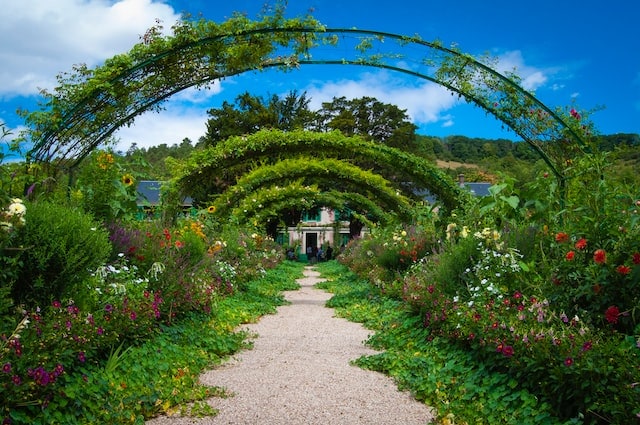
There were several ancient historians who praised the Hanging Gardens of Babylon for their scale, beauty, and technical skill. Unfortunately, their accounts vary a lot, so it has become very difficult for contemporary historians and archaeologists to visualize the garden or provide evidence for its existence.
Some recount that the Gardens were designed during the time of King Nebuchadnezzar II. It’s believed that he designed the Gardens to be sloped like a mountain so that it could console his Queen’s homesickness. She hailed from Media, the Northwestern part of Iraq, which was more of a mountainous region.
Other recounts mention the garden was built by Sammu-Ramat or Sennacherib of Nineveh in the 7th Century B.C. (almost a century earlier than Nebuchadnezzar II). It’s also possible that the Hanging Gardens were built by a team of architects, engineers, and craftsmen working under the direction of the king. Despite the lack of concrete information about who designed the Hanging Gardens, they continue to be a source of fascination and mystery for people around the world.
Where were the Hanging Gardens of Babylon?

Among all the other ancient wonders listed by Herodotus, the Hanging Gardens of Babylon is the only one whose exact location is still disputed by historians. Although the name suggests that it may have been in Babylon, there’s not enough evidence to prove this.
Stephanie Dalley, a British Assyriologist, has a very convincing theory that the location of the Hanging Gardens might have been in Nineveh and that Sennacherib was the ruler who ordered its construction.
Nineveh is an Assyrian city that was located 300 miles north of Babylon. Currently, there’s more evidence in favor of this theory, as present-day archaeologists have uncovered the remains of an extensive network of aqueducts and other structures used to carry water in Nineveh. They also have evidence of the Archimedes screw, which was said to pump water into the upper levels of the gardens.
Even though the findings and speculation of Dalley prove to be quite valuable and insightful, experts are still unsure of where the gardens are located.
Apart from the writing of Josephus, a Jewish-Roman historian, there’s not enough proof to claim that Nebuchadnezzar II was involved. Modern scholars theorize that Josephus might have made a mistake. Besides, he was quoting Berossus, a Babylonian priest who mentions the existence of the gardens in 290 B.C. and assumes it to be during the reign of Nebuchadnezzar II.
How Historians Described the Hanging Gardens of Babylon

Primarily, there were five writers or historians who documented the Hanging Gardens of Babylon:
- Josephus (37-100 A.D)
- Diodorus Siculus (60 – 30 B.C)
- Quintus Curtius Rufus (100 A.D)
- Strabo (64 B.C – 21 A.D)
- Philo (400-500 A.D)
From these, Josephus has the oldest known records of the gardens and directly attributes it to the reign of King Nebuchadnezzar II.
Because of Josephus’s account being the oldest and the Babylonians being well-known for their feats of architecture (such as the Gates of Ishtar, the temple of Marduk, and a sprawling city structure), this claim made by Josephus holds a lot of weight.
As such, many people theorize that Nebuchadnezzar II was the canonical founder of the Hanging Gardens of Babylon.
However, there’s been no documentation or archeological evidence pointing to the gardens being erected in Babylon. None of the cuneiform tablets reference the gardens. On top of that, after intense excavations carried out by Robert Koldewey, a German archeologist, he could not find any conclusive proof to support the existence of these gardens.
Meanwhile, the majority of the writers didn’t specify the name of the king who ordered the structure to be designed. Instead, they vaguely refer to him as “a Syrian king,” meaning that it could be Nebuchadnezzar II, Sennacherib, or someone else entirely.
The Structure of the Hanging Gardens
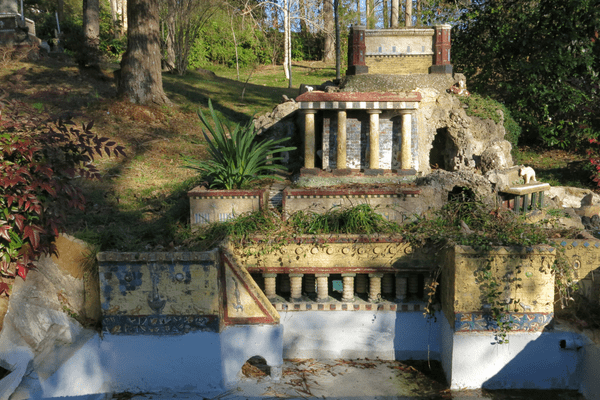
These writers and historians have many things to say about the mechanisms, structure, and overall appearance of the garden, but the basic idea remains the same.
In most recounts, the garden was said to have been a square-shaped structure surrounded by walls made out of bricks. These walls were said to have been as high as 75 feet, with a thickness of 20 feet thick. Along with that, each side of the square-shaped garden was said to have been around 100 feet long.
These garden beds were laid out in such a way that they created a terraced or ziggurat style, with adjacent garden beds (or levels) being placed higher or lower in elevation. The beds were also said to be deep enough to support the deep roots of date palms, fig trees, almond trees, and many other ornamental trees.
The garden beds, or the balconies on which plants were sown, were said to be layered with different materials such as reeds, bitumen, bricks, and cement, and preserved the structural integrity of the garden while preventing water from corrupting the foundations.
The Gardens were also said to include a sophisticated system of water features such as ponds and waterfalls, which on top of quenching the plants, also added to the overall atmosphere.
It was also said to have intricate hardscapes such as walking paths, balconies, trellises, fences, statues, and benches, providing a safe haven for members of the royal family to enjoy nature and de-stress.
Irrigation Mechanism of the Hanging Gardens of Babylon

The exquisite landscaping, irrigation mechanisms, structural architecture, and horticulture practices of the Hanging Gardens were unrivaled.
One such marvelous feat that was considered next to impossible was the issue of pumping up water into the upper levels or garden beds. Even though the Euphrates River provided more than enough water to maintain the plants, pushing them up to higher levels was an arduous task.
Although there’s not enough archeological evidence, many experts theorize that a variation of the chain pump or an Archimedes screw system was used to pump water into these huge garden beds that were “suspended” almost 100 feet from the river.
The latter makes a lot of sense because there has been enough historical and archeological proof of extensive waterways and raising mechanisms used in the city of Nineveh during Sennacherib’s reign.
Wrapping Up
The Hanging Gardens of Babylon remain a true mystery, as their existence cannot be thoroughly denied nor accepted. As such, we cannot refute its existence as several ancient writers and historians, despite varied recollections, praised this structure as one of mankind’s greatest achievements.
Were the Hanging Gardens of Babylon real, or an exaggeration of Sennacherib’s gardens in Nineveh? We may not know for sure when considering the current archeological findings and the state of the ruins of modern-day Iraq.





